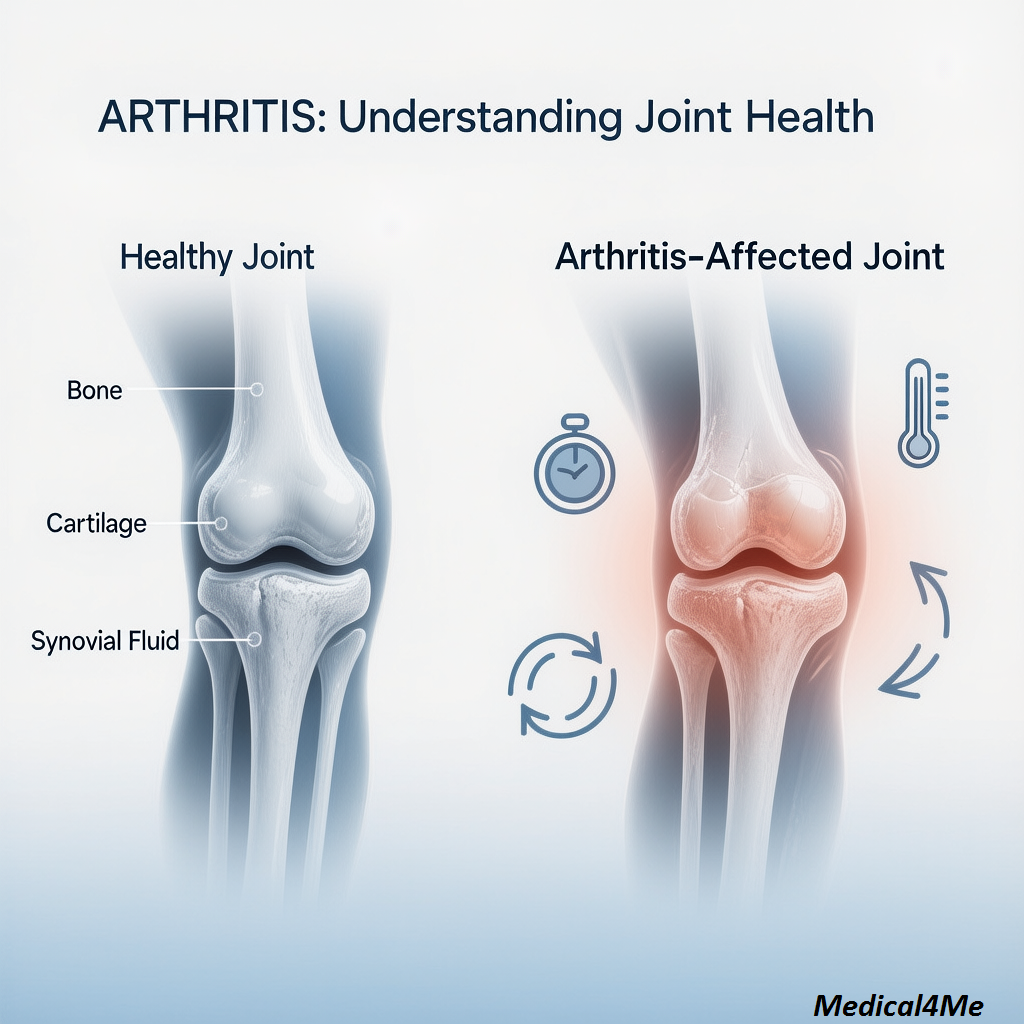Arthritis: Complete Medical Guide from Dr. Saqlain Mushtaq
When Your Joints Tell a Different Story
Furthermore, just finished seeing Mrs. Khalid, and I’m sitting here with my evening tea thinking about her arthritis pain. “Doctor sahib,” she said, “my hands feel like they’re wearing gloves made of broken glass.” That’s the kind of description that stays with you after clinic hours.
Additionally, you know what’s frustrating? When people dismiss joint pain as just “getting old.” Mrs. Khalid is only 42, runs her own business, and was in tears because she couldn’t open her daughter’s water bottle. That’s when arthritis becomes real – not in textbooks, but in these everyday moments.
Therefore, if you’re reading this at night, googling your symptoms and worrying, I get it. Let me share what I’ve learned from treating hundreds of patients here at Medical4Me. Hopefully, it’ll help you understand what’s happening in your body.

What Arthritis Actually Is (Not What Google Tells You)
Understanding the Basics
First of all, here’s the thing – arthritis isn’t one disease. Instead, it’s like saying “car problems” when you could have anything from a flat tire to engine failure.
Actually, let me explain this better. Think of your joints as door hinges. Normally, they’re smooth and work without you thinking about them. However, with arthritis, it’s different. Either sand gets poured into those hinges (osteoarthritis) or your body attacks the hinges (rheumatoid arthritis). In fact, there are over 100 types, but these two are the main ones I see daily.
Real Patient Examples
For instance, Mr. Goni came in last week, confused about his diagnosis. His doctor in Karachi called it “joint disease,” but here they’re calling it osteoarthritis. Same thing, different names. Moreover, what bothers me is when websites claim they have the “cure” for arthritis. If there was a cure, don’t you think I’d prescribe it?
Subsequently, the WHO data shows that about 350 million people worldwide have arthritis. That’s 350 million stories of morning stiffness and dropped coffee cups.
How Joints Work
Meanwhile, your joints are amazing structures. They’re where bones meet, cushioned by cartilage and held by ligaments. Nevertheless, when arthritis sets in, this whole system breaks down. Cartilage wears away like brake pads on a car.
How Arthritis Symptoms Really Feel
Morning Stiffness Experience
Initially, forget the medical descriptions. Let me tell you how my patients describe it. The morning stiffness isn’t just being creaky. Mrs. Patel told me it’s like her fingers were dipped in cement overnight. As a result, she sets her alarm 30 minutes early just to flex her hands enough to make breakfast.
Pain and Swelling Patterns
Then there’s the swelling. Not obvious “injury” swelling. Instead, it’s subtle. Your rings don’t fit. Your shoes feel tight. Similarly, Mr. Thompson didn’t notice his knuckles were swollen until his grandson asked why his fingers were “fat.”
Additionally, the fatigue hits different too. It’s not regular tiredness. One patient said: “It’s like my body is working overtime just to exist.”
Daily Life Impact
Moreover, what really gets to people is the unpredictability. Good days and bad days with no warning. The weather changes, and suddenly your grandmother’s saying about feeling rain in her bones makes sense. Although we still don’t fully understand why pressure affects joint pain, I’ve seen it too many times to dismiss it.
Finally, the stiffness after sitting is another thing. You watch a movie, stand up, and walk like a robot for the first few steps.
Why Arthritis Happens (The Simple Truth)
Osteoarthritis Causes
First, let’s talk about why this happens to good people. Osteoarthritis is partly wear and tear, yes. However, it’s not just about age. I’ve seen 30-year-olds with it and 80-year-olds without it. Therefore, your genes play a huge role – if your mother had it, you’re more likely to get it.
Furthermore, weight is a factor, and I hate bringing it up. It’s not fat-shaming – it’s physics. Every extra pound puts four pounds of pressure on your knees. Nevertheless, thin people get arthritis too, so it’s not the whole story.
Rheumatoid Arthritis Triggers
Meanwhile, rheumatoid arthritis is different. Your immune system goes rogue. Why? We think it’s genes plus triggers – maybe a virus, stress, or smoking. Women get it more, especially around hormonal changes.
For example, Mrs. Ali came in last month, angry about getting rheumatoid arthritis despite doing “everything right.” Sometimes there’s no one to blame. Your body just decides to be difficult.
Additionally, other causes include gout, lupus, and psoriasis. Like with other conditions we treat, the cause determines the treatment approach.
The Diagnosis Journey (What to Expect)
Initial Doctor Visit
Initially, getting diagnosed isn’t always simple, which frustrates patients. You go to your doctor with joint pain. They’ll examine you and ask many questions. When did it start? Morning stiffness? Family history? Subsequently, they’re not being nosy – patterns matter in diagnosis.
Medical Tests Explained
Then come the tests. Blood tests look for inflammation markers and antibodies. Don’t Google these – you’ll stress yourself out. Furthermore, X-rays show bone changes but can miss early arthritis. MRIs are better but expensive.
Moreover, the Mayo Clinic explains that diagnosis often takes multiple visits. That’s normal, not incompetence.
Emotional Journey
For instance, Mr. Malik saw three doctors before getting his rheumatoid arthritis diagnosis. His anti-CCP was very high. Treatment started immediately.
Additionally, here’s what nobody tells you – the emotional part. Relief that you’re not imagining it. Fear about the future. Anger at your body. All normal. All valid.
Treatment Options That Actually Work (With Real Costs)
Medications and Costs
First, let me be straight about treatments and costs. For osteoarthritis, we start simple. Pain relievers cost about $10-20 monthly. If that doesn’t work, prescription NSAIDs run $50-100 monthly with insurance. Additionally, topical creams help some people. Voltaren gel is now over-the-counter, about $15 a tube.
Physical Therapy Benefits
Meanwhile, physical therapy is gold standard but expensive – $50-150 per session. Usually, you need 8-12 sessions. Nevertheless, it’s worth every penny if you can afford it. The exercises they teach you are forever.
Advanced Treatments
Subsequently, injections come next. Cortisone shots cost $100-300 and last 3-6 months if lucky. Joint fluid injections run $500-800, not always covered by insurance.
For rheumatoid arthritis, it’s different. DMARDs are essential. Methotrexate is cheap, maybe $20 monthly. However, biologics like Humira? They cost $5,000-7,000 monthly without insurance. With insurance and patient help programs, maybe $50-100.
Surgery and Alternative Options
Furthermore, surgery is last resort. Knee replacement: $35,000-70,000. Recovery takes months. But when you need it, you need it.
Additionally, alternative treatments exist. Swimming is perfect exercise for arthritis. Gym membership costs $30-50 monthly, worth it.

Red Flags (When to Panic, When Not To)
Emergency Warning Signs
First, some joint pain is “see your doctor next week.” Some is “go to emergency now.” Sudden, severe joint pain with fever could be septic arthritis. That’s an emergency. Similarly, joint suddenly hot and red? Emergency.
Urgent but Not Emergency
Meanwhile, see your doctor within days if multiple joints hurt and you’re losing weight. Morning stiffness over an hour needs attention. Joint pain with rashes is concerning too.
Moreover, the CDC guidelines state that early treatment within 6 months dramatically improves outcomes. Therefore, don’t wait.
Non-Emergency Situations
However, chronic pain getting slightly worse usually isn’t emergency. Clicking without pain is common. Nevertheless, trust your gut if something feels really wrong.
Questions I Get Every Single Day
Common Concerns About Future
“Doctor, will I end up in a wheelchair?”
Probably not. Most people with arthritis never need wheelchairs. However, early treatment matters. That’s why I’m writing this late, hoping someone reads it and sees their doctor sooner.
“Can I still exercise?”
Yes! In fact, you SHOULD exercise. Movement is medicine for arthritis. Start slow. Pool exercises are perfect. Just don’t overdo it.
Family and Lifestyle Questions
“Is it hereditary?”
There’s genetic risk, yes. But genes aren’t destiny. If you have rheumatoid arthritis, your kids have maybe 5% chance. Therefore, 95% chance they won’t get it.
“What about diet?”
Mediterranean diet helps. Furthermore, some people swear cutting nightshades helps. Science doesn’t fully support it, but if it works for you, why not?
“Weather really affects it?”
Yes! As I mentioned in recent posts about this, pressure changes affect joint fluid. You’re not imagining it.
What You Need to Do Tonight
Immediate Action Steps
Finally, I know you’re scared. Reading this at night, hoping it’ll go away. It won’t go away. However, it’s manageable. Really.
Therefore, tomorrow morning, call your doctor. Write down your symptoms tonight while they’re fresh. Take photos of swollen joints. Your doctor needs this information.
Starting Your Recovery
Moreover, start a symptom diary. Track pain levels, activities, weather, food. Patterns will emerge. Meanwhile, if waiting for appointments, start gentle exercises now. YouTube has great arthritis exercise videos.
Additionally, stop reading horror stories online at 2 AM. Join one good support group, not twelve. The Arthritis Foundation has solid resources.
The key takeaway? Arthritis is treatable, not curable, but absolutely manageable with the right approach. If you’re experiencing joint pain, stiffness, or swelling that’s affecting your daily life, please see your doctor.


💬 Share Your Experience
Share your thoughts, questions, or personal tips below. Our community and editorial team value respectful and insightful discussions.